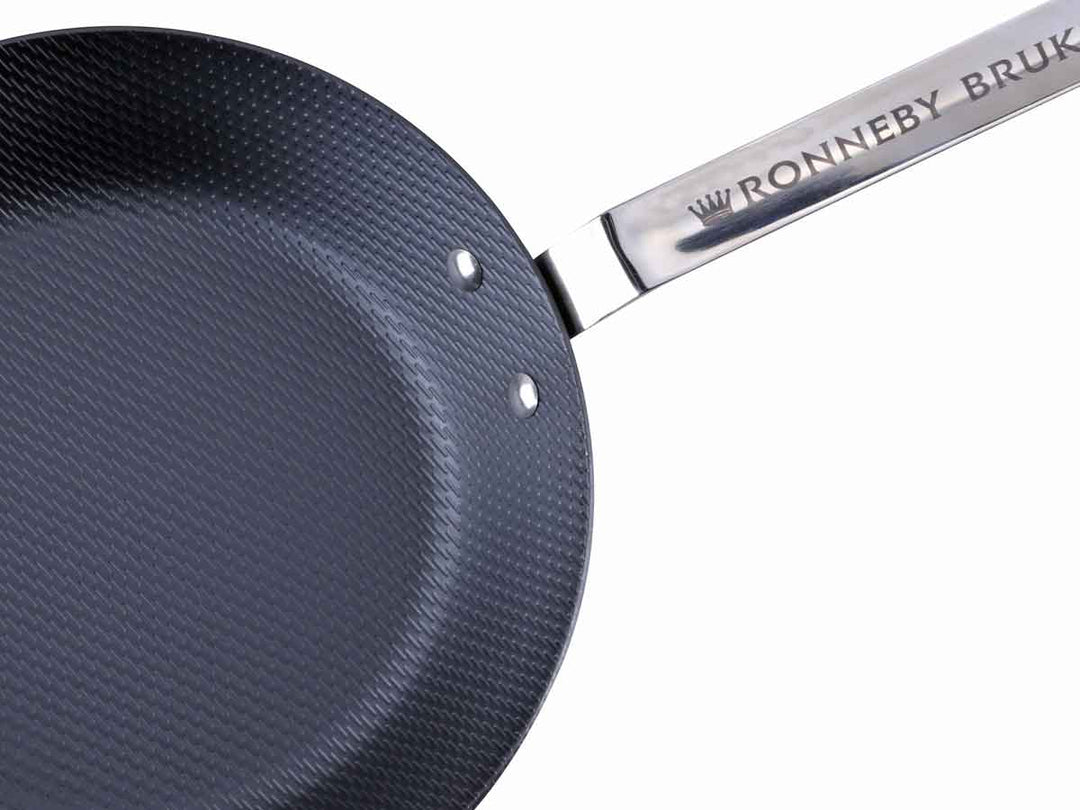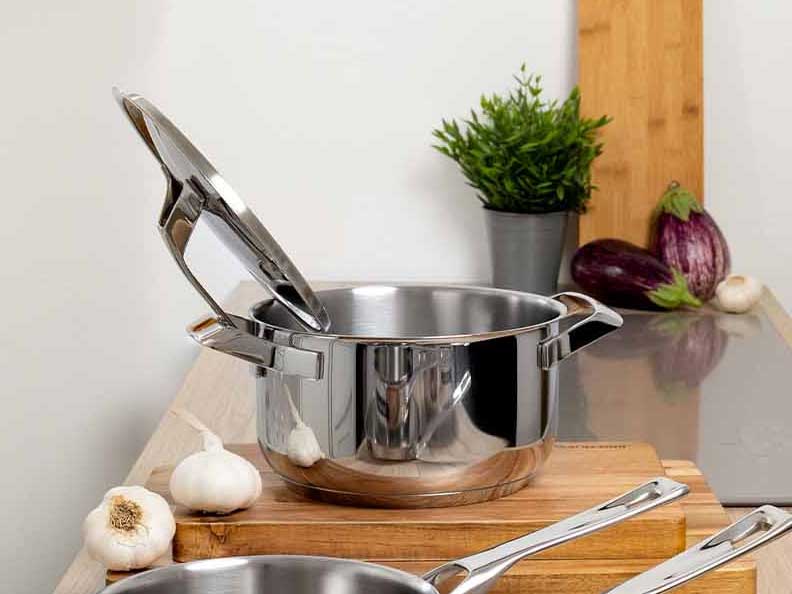types of stoves
What types of stoves are there, how do they work and what are the advantages/disadvantages?
There are four fundamentally different types of cookers in use today: gas , electric stoves (hot plates) , radiant hob / glass ceramic and induction . Each type of cooker has its own specific advantages and disadvantages, and not all cookware can perform in the same way on every cooker. In this respect, it is advantageous to familiarize yourself with the peculiarities of your own cooker and to keep them in mind when choosing the cookware.
gas stoves

The oldest type of stove still in use today is the gas stove. An open flame directly heats the base of the cookware.
The spread of gas stoves varies greatly in Europe: while electric stove types dominate in Germany, for example, gas stoves dominate in Italy.
The "gas under glass ceramic" technique is exotic and will not be discussed further here.
Advantages of a gas stove
+ Fast, instantaneous heat regulation
+ robust, durable
+ almost any cookware can be used
Disadvantages of a gas stove
- open flames pose a risk of fire and burns (always keep potholders, tea towels, etc. away from the flame)
- Heat often not so finely adjustable, especially in the lower areas
- Excessive flame can damage handles
Electric stoves (hotplates)

This type of electric stove was the standard for decades and can still be found today in many rented apartments as basic equipment. In a cast-iron plate, ring-shaped heating wires are embedded in insulating compound on the underside. For reasons of thermal expansion, there is an unheated depression in the middle. The heating wires heat the plate and this then heats up the bottom of the cookware through heat conduction.
In other parts of the world, spiral-shaped electric hotplates are also common.
Advantages of an electric stove (hotplate)
+ robust and durable
+ almost any cookware can be used
Disadvantages of an electric stove (hotplate)
- long heating-up time
- very sluggish / long delay in heat regulation
- Cooking zones remain very hot for a long time after use (risk of fire/burns)
Radiant heaters / glass ceramic hobs

In the second half of the 20th century, an innovation in electric stoves found its way into many kitchens, the glass ceramic hob. It quickly gained popularity, above all because of its completely different appearance, which enabled it to be elegantly integrated into the worktop.
Heating elements are located under a largely expansion-neutral pane made of glass ceramic. The heat radiation from the heating elements penetrates the glass ceramic and is absorbed by the base of the cookware. This is the main form of heat transfer.
Heat is only secondarily transferred from the glass ceramic to the base of the cookware, as is the case with an electric mass cooker.
Advantages of a glass ceramic hob
+ visually appealing
Disadvantages of a glass ceramic hob
- long heating-up time
- very sluggish / long delay in heat regulation
- Cooking zones remain very hot for a long time after use (risk of fire/burns)
- Cooking zone that is too large can damage handles
- Ceramic glass can scratch or, in extreme cases, break
induction cooker

Induction technology is the current state of development in the field of electric stoves. Thanks to falling prices, an induction hob today often costs little more than a glass ceramic/radiant heater hob, from which it can hardly be distinguished when switched off, because here too, a largely expansion-neutral pane of glass ceramic forms the face of the hob to the outside
Ring-shaped coils made of copper mesh are located under the glass ceramic. Controlled by electronics, these generate an oscillating magnetic field, which excites an eddy current in the base of the cookware, which in turn generates heat due to the resistance of the base.
In the case of induction hobs, heat is not transferred to the cookware by thermal conduction (as with electric mass hotplates) or by thermal radiation (as with glass ceramic hobs), but is "generated" directly in the base of the cookware. As a result, there is only little energy loss, which makes this type of cooking very efficient.
How do I test if my cookware is induction-suitable?
Take a magnet (e.g. a fridge magnet) and hold it on the underside (contact surface) of the cookware. If the magnet sticks, the base is ferromagnetic and therefore in principle suitable for induction cookers.
Advantages of an induction cooker
+ extremely fast, basically like gas
+ can be finely dosed
+ hardly any risk of fire and only low risk of burns; The cooktop gets no more than as hot as the cookware due to the heat transferred back from the cookware
+ Comparatively energy-saving cooking possible
+ visually appealing
Disadvantages of an induction cooker
- only works with suitable cookware (base must be ferromagnetic)
- Not every cookware that is in principle suitable for induction is also recognized by the hob electronics (very small diameters are often problematic)
- Whistling/humming noises can occur with multi-layer cookware (e.g. stainless steel with thermal base) (see below)
- Heat regulation in the lowest power levels is often carried out by means of a pulsed on/off switch (as with microwaves), so a base with good heat storage is advantageous for smoothing out the waviness
- Potentially more susceptible to interference due to the large number of electronics
- Ceramic glass can scratch or, in extreme cases, break
Noises - Why is the pan whistling or humming on the induction hob?
When used on the induction hob, some pots and pans make noises that can be described as humming, whistling or crackling. Contrary to what some customers suspect, this has nothing to do with the quality of the respective cookware, but with the construction:
This phenomenon only affects cookware with a multi-part base, i.e. stainless steel cookware with thermal/sandwich/capsule base and induction-suitable aluminum/cast aluminum cookware.
The reason for the noise development lies in the different vibration behavior of the various interconnected materials in the base in response to the eddy currents induced by the induction hob, which causes the molecules of the base components to vibrate in order to generate heat.
The occurrence and intensity of the noise also depends on many factors that have nothing directly to do with the cookware: size of the induction coil in relation to the base of the cookware, selected power level, operating frequency of the cooktop, level of cookware, simultaneous use of other cooktops and much more .
Noise generation harmless and not a material defect
Even if the noises that sometimes occur when cooking on induction can sometimes be shrill and unpleasant, you don't need to worry about your hob or cookware: neither of these will be damaged by the noise.
Incidentally, the noise generated by cookware on induction cooktops is never a reason for a complaint.
Which cookware makes no noise on induction?
The noise development on induction cooktops can only be avoided by using one-piece cookware, e.g. cast iron pans, iron/steel pans or steel-enamel pans.
Due to its stability, the classic cast iron pan in particular is perfect for modern induction cookers.






